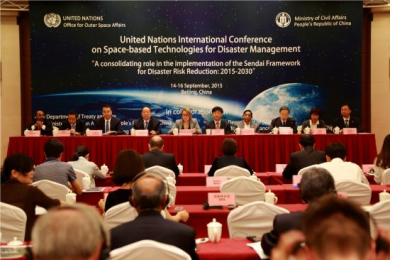The United Nations International Conference on Space-based Technologies for Disaster Management - "A consolidating role in the implementation of the Sendai Framework for Disaster Risk Reduction: 2015-2030 “ was successfully conducted from 14 to 16 September 2015. The conference was co-organized by UN-SPIDER Beijing Office of the UN Office for Outer Space Affairs (UNOOSA) and the Ministry of Civil Affairs of the People’s Republic of China (PRC), in collaboration with the Department of Treaty and Law, Ministry of Foreign Affairs (MoFA) of PRC, the Department of System Engineering of China National Space Administration (CNSA) of PRC, the Asia Pacific Space Cooperation Organization (APSCO) and with the support of DigitalGlobe.
The conference was attended by more than 100 participants from about 32 countries representing 82 organizations from Asia, Africa, Europe, Latin America and the Caribbean regions to discuss the role of Earth observation technologies in the implementation of the “Sendai Framework on Disaster Risk Reduction: 2015-2030”.
Mr. Gu Chaoxi, Vice Minister of Civil Affairs of PRC, Mr. Mofazzal Hossain Chowdhury, Minister of Disaster Management and Relief of Bangladesh and Ms Simonetta Di Pippo, Director of UNOOSA graced the occasion of opening ceremony along with the senior officials from CNSA, Ministry of Foreign Affairs of PRC and APSCO.
The conference was comprised of a Key note session, 5 plenary sessions, 3 parallel working group sessions, institutional visits to two organisations and a concluding session. The experts and officials from different part of the World led the deliberations in the plenary sessions and parallel working groups. The institutional visits were planned to the organisations namely, Yungang Satellite Earth Station of CNSA and National Disaster Reduction Centre of China.
The plenary sessions discussed following unique and important themes: 1) Earth observation in understanding disaster risk (reference to Priority 1 of the Sendai Framework for DRR) 2) Earth observation in enhancing preparedness for effective response (reference to Priority 4 of the Sendai Framework for DRR) 3) Foster public and private collaboration 4) Empowering the communities to prepare for disasters 5) Engaging with UNOOSA/UN-SPIDER in the streamlining of EO in decision-making for DRR and sustainable development.
The key note presentations delivered by 5 speakers namely, Simonetta Di Pippo (Director, UNOOSA), Mofazzal Hossain Chowdhury (Minister of Disaster Management and Relief, Bangladesh), Li Deren (Academician, Wuhan University), Sujit Mohanty (UNISDR, Asia Pacific Regional Office), and Shirish Ravan (UN-SPIDER Beijing Office) provided insight of the conference theme and set tone of the conference. A total of 21 presentations were delivered during the first four plenary sessions and all sessions offered optimal time to seek inputs/suggestions/comments from the participants. During session 5, the representatives of 15 countries/organisations engaged with UN-SPIDER/UNOOSA delivered the short lightening talks.
The working groups covered following themes: 1) Drought – How UN-SPIDER network can support? 2) Lesson Learned from Nepal Earthquake – Earth observation perspective 3) Capacity building and emerging technologies. About 12 presentations were delivered in the working groups and majority time was devoted to discuss the key questions posed by the Chairs of the working group. The working group summary was provided at the end of the working group discussions.
The concluding session brought together Chairs of all plenary sessions on the dais and the synthesis of each plenary session was presented by the respective Chair persons. This synthesis captured inputs from all panelists and also reflected the comments and suggestions made by the participants.
The detailed agenda and presentations of the conference can be downloaded from the Conference website.

